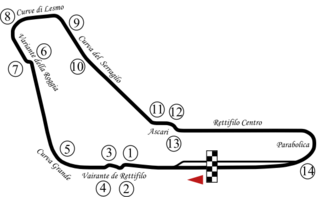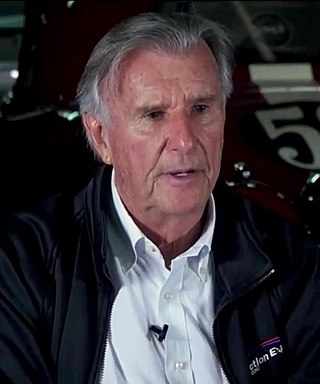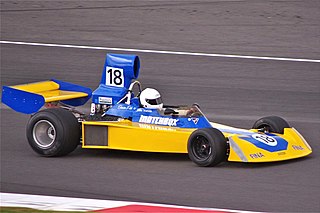Motor Racing Developments Ltd., commonly known as Brabham, was a British racing car manufacturer and Formula One racing team. Founded in 1960 by Australian driver Jack Brabham and British-Australian designer Ron Tauranac, the team won four Drivers' and two Constructors' World Championships in its 30-year Formula One history. Jack Brabham's 1966 FIA Drivers' Championship remains the only such achievement using a car bearing the driver's own name.

The 1972 Spanish Grand Prix was a Formula One motor race held at Jarama on May 1, 1972. It was race 3 of 12 in both the 1972 World Championship of Drivers and the 1972 International Cup for Formula One Manufacturers. The race marked the first time two brothers raced together in F1 simultaneously, Emerson and Wilson Fittipaldi. The elder Fittipaldi was a last-minute substitute for Brabham's Carlos Reutemann, who had injured his ankle in a Formula 2 race the previous weekend at Thruxton, England. The 90-lap race was won by Lotus driver Emerson Fittipaldi after he started from third position. Jacky Ickx finished second for the Ferrari team and his teammate Clay Regazzoni came in third. After the race the World Drivers' Championship was tied at 15 points between Emerson Fittipaldi and Denny Hulme.

The 1973 Grand Prix of Sweden was a Formula One motor race held at the Scandinavian Raceway, Anderstorp on 17 June 1973. It was race 7 of 15 in both the 1973 World Championship of Drivers and the 1973 International Cup for Formula One Manufacturers. The 80-lap race was won by McLaren driver Denny Hulme after he started from sixth position. Ronnie Peterson finished second for the Lotus team and Tyrrell driver François Cevert came in third.

The 1974 Argentine Grand Prix was a Formula One motor race held in Buenos Aires on 13 January 1974. It was race 1 of 15 in both the 1974 World Championship of Drivers and the 1974 International Cup for Formula One Manufacturers. The 53-lap race was won by McLaren driver Denny Hulme after he started from tenth position. Niki Lauda finished second for the Ferrari team and his teammate Clay Regazzoni came in third.

The 1975 German Grand Prix was a Formula One motor race held at Nürburgring on 3 August 1975. It was race 11 of 14 in both the 1975 World Championship of Drivers and the 1975 International Cup for Formula One Manufacturers. It was the 37th German Grand Prix and the 34th to be held at the Nürburgring. The race was held over 14 laps of the 22.8-kilometre (14.2 mi) circuit for a race distance of 319 kilometres (198 mi).

The 1978 British Grand Prix was a Formula One motor race held at Brands Hatch on 16 July 1978. It was the tenth race of the 1978 World Championship of F1 Drivers and the 1978 International Cup for F1 Constructors.
The 1980 Canadian Grand Prix was a Formula One motor race held on 28 September 1980, at the Circuit Île Notre-Dame in Montreal, Quebec, Canada. It was the thirteenth and penultimate race of the 1980 Formula One season. The race was the 19th Canadian Grand Prix and the third to be held in Montreal. The race was held over 70 laps of the 4.41-kilometre circuit for a total race distance of 309 kilometres.

The 1981 Italian Grand Prix was a Formula One motor race held at Monza on 13 September 1981. It was the thirteenth race of the 1981 Formula One World Championship.

The 1980 Formula One season was the 34th season of FIA Formula One motor racing. It featured the 1980 World Championship of Drivers and the 1980 International Cup for F1 Constructors, which were contested concurrently from 13 January to 5 October over a fourteen-race series. The season also included one non-championship race, the Spanish Grand Prix.

The 1971 Formula One season was the 25th season of the Fédération Internationale de l'Automobile's Formula One motor racing. It featured the 22nd World Championship of Drivers and the 14th International Cup for F1 Manufacturers which were contested concurrently over eleven races between 6 March and 3 October. The season also included a number of non-championship races open to Formula One cars.

Wilson Fittipaldi Júnior is a Brazilian former racing driver and Formula One team owner. He participated in 38 World Championship Formula One Grands Prix, debuting on May 1, 1972, scoring a total of three championship points. He ran the Fittipaldi Formula One team between 1974 and 1982. He also participated in numerous non-Championship Formula One races.
Rondel Racing was a British racing team that competed in the Formula Two series between 1971 and 1973. The team was founded by two ex-Brabham mechanics Ron Dennis and Neil Trundle. Rondel won five European Championship races before being forced to close down in 1973 due to a number of factors including lack of money, loss of Motul support and NatWest Bank calling in a £5,000 overdraft over a workshop floor installed by Dennis.

The BRM P138 was a Formula One racing car designed by Len Terry which raced in the 1968 and 1969 Formula One seasons. It was powered by a 3.0-litre V12 engine.

The Tyrrell 002 is a Formula One racing car which was designed for the 1971 and 1972 Formula One seasons by Tyrrell's Chief Designer, Derek Gardner. It was essentially the same design as the Tyrrell 001, but incorporated some detail changes, and 002 were built with longer monocoques, as François Cevert was taller than Jackie Stewart.

The Williams FW was a Formula One car used by Frank Williams Racing Cars during the 1973, 1974 and 1975 seasons. It was designed by John Clarke.

The Fittipaldi FD was a series of Formula One chassis designed by Richard Divila and used by Fittipaldi Automotive in the 1975, 1976 and 1977 seasons. The initial chassis was designated Fittipaldi FD01 and there were three minor developments designated, Fittipaldi FD02, Fittipaldi FD03 and Fittipaldi FD04 respectively. FD series cars competed in 37 races making 43 individual entries in total. The chassis achieved a best finish of fourth place at both the 1977 Argentine and Brazilian Grands Prix driven on each occasion by former World Champion and joint team-owner Emerson Fittipaldi. It scored a total of 11 World Championship points.

The Surtees TS16 was a Formula One car used by Surtees during the 1974, 1975 and 1976 Formula One seasons. It was designed by John Surtees.

The Surtees TS9 was a Formula One car used by Surtees during the 1971, 1972 and 1973 Formula One seasons. It was designed by John Surtees and Peter Connew.

The Surtees TS14 was a Formula One car used by Surtees during the 1972 and 1973 Formula One seasons. It was designed by John Surtees.

The Surtees TS19 was a Formula One (F1) car used by Surtees during the 1976, 1977 and 1978 F1 seasons. It was designed by John Surtees and Ken Sears.


















